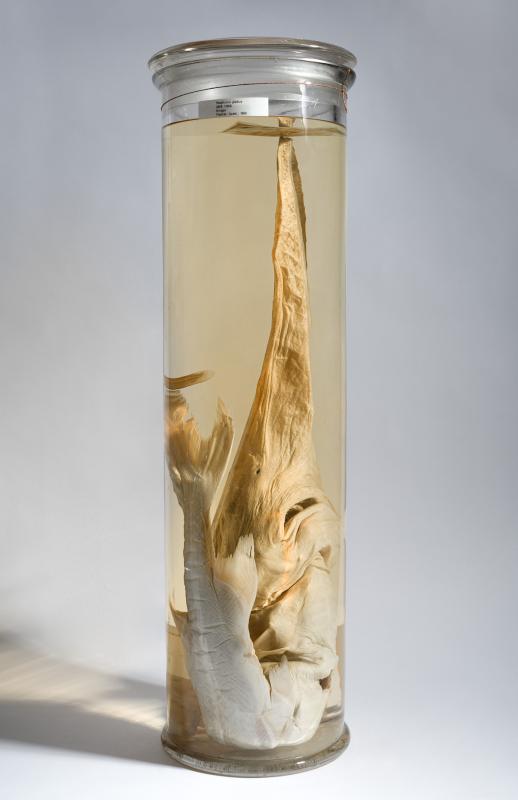"Psephurus gladius (Martens, 1862), 'Chinese paddlefish', ZMB 11002, 1,190 mm total length, Ning-po-fu on the lower reaches of the Jun-ho, International Fishery Exhibition Berlin, 1880" – This is the brief profile of only one of its kind between the many valuable objects in the collection of the Museum für Naturkunde Berlin.
In the course of the Prussian East Asia Expedition (1859-1861), Eduard von Martens, later a well-known Berlin zoologist, discovered this strange fish for science on 3 March 1861 "in the house of a Chinese fishmonger at Woosung". In his description of the species, he already recognized the close relationship to its American counterpart, the paddlefish Polyodon spathula from the Mississippi.
The Chinese paddlefish, liked to eat fish – not plankton and small crustaceans like its American relative. Its narrow, sword-like "nose" was densely filled with electrical sensory organs that helped locate its prey in murky waters. Like a balancing rod, the sword also helped to stabilise swimming in the case of sudden change in water pressure when opening its mouth. The origins of the paddlefish, once growing up to seven meters, can be traced back 200 million years.

In 2010, when the museum's east wing opened with its valuable wet collections as research infrastructure, the Chinese paddlefish was already extinct. Although protected in China, this impressive fish shared the fate with its European relatives. Intensive fishing, water pollution and migration obstacles – such as dam construction, inhibiting spawing migrations, finally eliminated the last individuals from earth.
Following the IUCN Red List, the last individual, died between 2005 and 2010. After many years of searching, this creature has been officially listed as extinct since 2020. Visible to everyone, the Berlin specimen of the Chinese paddlefish is preserved for all time in the wet collection of the museum's east wing. As several other globally extinct species in the same collection, is now acts as a reminder and research object.
We hope that freshwater biodiversity comes more into the focus of attention at the Biodiversity COP in Montreal, not to assess more and more fish species following the pathway of the Chinese paddlefish.
This text is part of the campaign "Safeguarding nature!" for the World Nature Summit 2022 in Montreal.
Text: Dr. Gesine Steiner
Pictures: Hwa Ja Götz, J. Kramer
